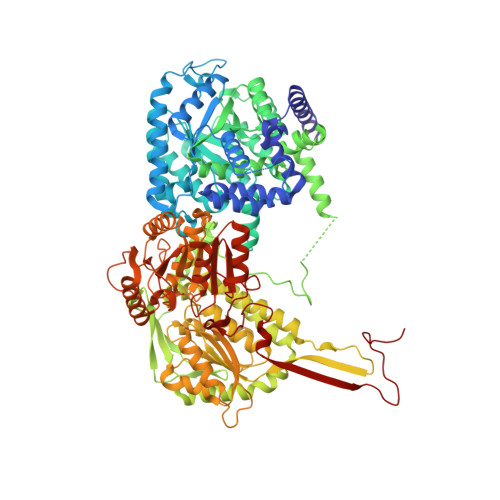Probing the function of a ligand-modulated dynamic tunnel in bifunctional proline utilization A (PutA).
Korasick, D.A., Christgen, S.L., Qureshi, I.A., Becker, D.F., Tanner, J.J.(2021) Arch Biochem Biophys 712: 109025-109025
- PubMed: 34506758
- DOI: https://doi.org/10.1016/j.abb.2021.109025
- Primary Citation of Related Structures:
7NA0 - PubMed Abstract:
In many bacteria, the reactions of proline catabolism are catalyzed by the bifunctional enzyme known as proline utilization A (PutA). PutA catalyzes the two-step oxidation of l-proline to l-glutamate using distinct proline dehydrogenase (PRODH) and l-glutamate-¦Ă-semialdehyde dehydrogenase (GSALDH) active sites, which are separated by over 40?? and connected by a complex tunnel system. The tunnel system consists of a main tunnel that connects the two active sites and functions in substrate channeling, plus six ancillary tunnels whose functions are unknown. Here we used tunnel-blocking mutagenesis to probe the role of a dynamic ancillary tunnel (tunnel 2a) whose shape is modulated by ligand binding to the PRODH active site. The 1.90?? resolution crystal structure of Geobacter sulfurreducens PutA variant A206W verified that the side chain of Trp206 cleanly blocks tunnel 2a without perturbing the surrounding structure. Steady-state kinetic measurements indicate the mutation impaired PRODH activity without affecting the GSALDH activity. Single-turnover experiments corroborated a severe impairment of PRODH activity with flavin reduction decreased by nearly 600-fold in A206W relative to wild-type. Substrate channeling is also significantly impacted as A206W exhibited a 3000-fold lower catalytic efficiency in coupled PRODH-GSALDH activity assays, which measure NADH formation as a function of proline. The structure suggests that Trp206 inhibits binding of the substrate l-proline by preventing the formation of a conserved glutamate-arginine ion pair and closure of the PRODH active site. Our data are consistent with tunnel 2a serving as an open space through which the glutamate of the ion pair travels during the opening and closing of the active site in response to binding l-proline. These results confirm the essentiality of the conserved ion pair in binding l-proline and support the hypothesis that the ion pair functions as a gate that controls access to the PRODH active site.
Organizational Affiliation:
Department of Biochemistry, University of Missouri, Columbia, MO, 65211, United States.

















